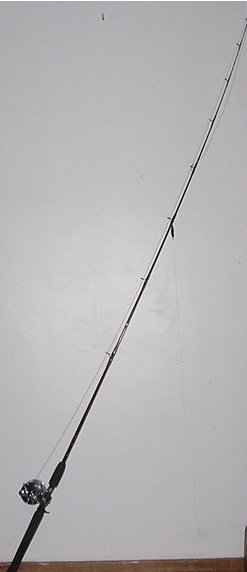Trolling for trout has been a proven effective method of fishing for years now, probably since the introduction of the first outboard motors. It doesn't get much easier than letting your lure back about 100' behind the boat and creeping around at 2-4 mph. This method works fine when the surface temps of the lake are at 65 degrees or less. However, during the warmer months lake surface temps. can reach in excess of 75 degrees and the trout are forced to move deeper to find their comfort zone. This is when the leadcore troller can find superb action while others go blank!
Trolling Gear
The Rod
You will need a fairly long, medium action rod suitable for 12-25 pound test. I use a 7' Penn Power Graph Medium-Heavy action rod. The long length and stiff backbone helps with the hook-set, which is necessary because the leadcore line will usually "sag or droop" when trolled and you'll need a long swing to make up for the slack line.
The Reel
You'll need a large level-wind reel capable of holding at least 300 yds. of #20 test. The level-wind is necessary because it helps keep your line from bunching up - which can damage the braided line. The Penn 209 level-wind has been a popular choice for leadcore anglers throughout the years because of it's price and durability. This is what I use and it works fine for me, but there are some newer level winds on the market with higher gear ratios which could also aid in keeping the "slack" out of the line.
The Line Leadcore line ranges from #12 to #20 test and generally comes in 100 yard spools. It is a braided nylon line with a hollow inner core that is filled with soft lead. It's usually color-coded at 10 yards per color. The general rule of thumb is the lure will sink 5 feet for every color of leadcore let out. This will vary of course, depending on trolling speed, lb test of leadcore, length of leader and type of lure you are using.
|  |
The Leader
I use #6 test Maxima fishing line, which is probably closer to #8 test when compared to other lines. I like it because it's very abrasion-resistant. You'll find when trolling leadcore (especially when first beginning) you will come into contact with the bottom a lot. Having a good abrasion-resistant line will sometimes make the difference between getting your lure back and not! I also believe Maxima's "Ultra-green" formula is one of the least visible line when underwater. Some people use flourocarbon and this is fine too. I'm not a big fan of the stuff but some people swear by it. Just make sure to use at least five feet of leader tied to a high quality precision ball-bearing swivel. The precision swivel will prevent "line-twist", a common problem when trolling some lures. Tie the other end of the swivel directly to the leadcore or "snubber" if you care to use one. A snubber is a sort of bungie cord that acts as a shock absorber. Since leadcore does not stretch like monofilament, a sudden run from a big fish can pull the hook out or snap the leader. I personally don't use one since I prefer the more direct contact with the fish for a better hook-set. I also have yet to hook a trout while trolling that will break my #6 Maxima, but I guess if I ever do, I may be sorry!
Lures
I could probably write an entire book on trolling lures for trout. I won't get into the hundreds of different types of trout lures and gizmos on the market but I do want to mention a key factor to remember when selecting a lure. Different lures will swim at different depths and this will affect how many "colors" of leadcore you need to let out to get to the desired depth. A deep diving crankbait will naturally swim deeper than a fluttering Needlefish spoon.
Trolling Technique
Trolling Speed
How fast you should troll depends on what type of lure you are using. Most of the time you want to troll just fast enough to bring a good action to your lure. Test this by letting a few feet of line out and dragging your lure next to the boat. Crankbaits should have a nice "wiggle" to them, a spoon should "wobble" and a spinner should "spin".
Trolling Depth
As mentioned before, the general rule of thumb is the lure will sink 5 feet for every color of leadcore let out. This will vary of course, depending on trolling speed, lb test of leadcore, length of leader and type of lure you are using. The only way to get a good idea on how deep you are running is trial and error. A fish finder is extremely helpful in determining this. Watch your graph and hold your rod and pay attention to how many colors you put out. If you start to feel your lure bumping the bottom at 35 feet, you know that's how much line you will need to let out to get your lure at that depth. Of course, you must also figure out what depth the fish are holding at as well. Once again, this is where a fish finder becomes an extremely helpful tool.
Other Tips
One of the biggest problems I have run across while trolling with leadcore is keeping the line tight after hooking a fish. As mentioned before, leadcore line will usually "sag or droop" when trolled causing a lot of slack in the line. My slow-ratioed Penn 209 probably does not help either. I have found a way to compensate this though and that is by leaving the motor in gear while reeling the fish in. This of course cannot always be done, especially if you are by yourself or on a very small lake and headed to the bank. But if you can get away with it, it's a good method for keeping the line tight and the fish connected to it! Another tip for running deeper is to add a 3/8-1/2 ounce sliding egg sinker just above the swivel. You'll have to re-calculate your "depth vs. colors of line" theory but it will definately get your lure down deeper without having to let so much line out. References: fishguppie, Muskyman, troll miester, greg
|
















 Reply With Quote
Reply With Quote